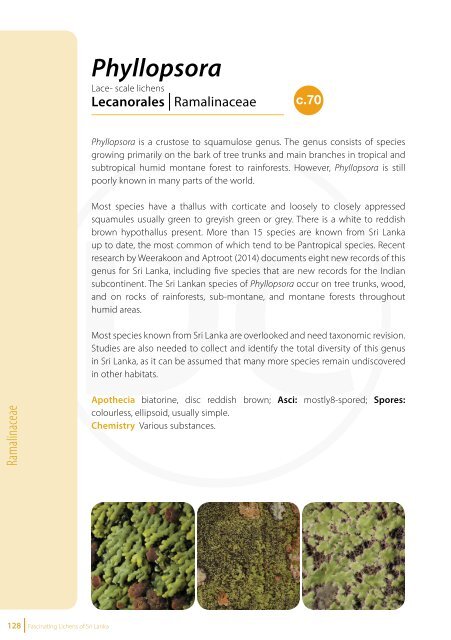You also want an ePaper? Increase the reach of your titles
YUMPU automatically turns print PDFs into web optimized ePapers that Google loves.
Phyllopsora<br />
Lace- scale lichens<br />
Lecanorales Ramalinaceae<br />
c.70<br />
Phyllopsora is a crustose to squamulose genus. The genus consists <strong>of</strong> species<br />
growing primarily on the bark <strong>of</strong> tree trunks and main branches in tropical and<br />
subtropical humid montane forest to rainforests. However, Phyllopsora is still<br />
poorly known in many parts <strong>of</strong> the world.<br />
Most species have a thallus with corticate and loosely to closely appressed<br />
squamules usually green to greyish green or grey. There is a white to reddish<br />
brown hypothallus present. More than 15 species are known from <strong>Sri</strong> <strong>Lanka</strong><br />
up to date, the most common <strong>of</strong> which tend to be Pantropical species. Recent<br />
research by Weerakoon and Aptroot (2014) documents eight new records <strong>of</strong> this<br />
genus for <strong>Sri</strong> <strong>Lanka</strong>, including five species that are new records for the Indian<br />
subcontinent. The <strong>Sri</strong> <strong>Lanka</strong>n species <strong>of</strong> Phyllopsora occur on tree trunks, wood,<br />
and on rocks <strong>of</strong> rainforests, sub-montane, and montane forests throughout<br />
humid areas.<br />
Ramalinaceae<br />
Most species known from <strong>Sri</strong> <strong>Lanka</strong> are overlooked and need taxonomic revision.<br />
Studies are also needed to collect and identify the total diversity <strong>of</strong> this genus<br />
in <strong>Sri</strong> <strong>Lanka</strong>, as it can be assumed that many more species remain undiscovered<br />
in other habitats.<br />
Apothecia biatorine, disc reddish brown; Asci: mostly8-spored; Spores:<br />
colourless, ellipsoid, usually simple.<br />
Chemistry Various substances.<br />
Phyllopsora borbonica<br />
Description The thallus is formed <strong>of</strong> small, adnate, isodiametric areolae (an<br />
island <strong>of</strong> thalli that develop on hypothallus) which are discrete to adjoined<br />
peripherally, and forms a more or less continuous crust centrally. Areoles are<br />
pale green and glabrous (smooth, not hairy). Isidia are absent. The prothallus is<br />
brownish black. Apothecia are abundant, rounded, simple, plane to moderately<br />
convex and reddish brown.<br />
IC<br />
R<br />
Sq<br />
Ramalinaceae<br />
Chemistry No lichen substances<br />
Status Mostly seen on mature tree trunks in very humid, shaded interiors. New<br />
record for the Indian sub continent and <strong>Sri</strong> <strong>Lanka</strong>.<br />
Habitat Mostly found in humid mid elevation to high elevation forests above<br />
1300 m.<br />
Locations Few places in Nuwara Eliya and Adam’s Peak trail.<br />
128 <strong>Fascinating</strong> <strong>Lichens</strong> <strong>of</strong> <strong>Sri</strong> <strong>Lanka</strong><br />
<strong>Fascinating</strong> <strong>Lichens</strong> <strong>of</strong> <strong>Sri</strong> <strong>Lanka</strong> 129















